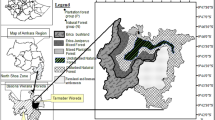Abstract
We describe the distribution ofPapio hamadryas in Saudi Arabia in relation to ecological constraints and recent changes in human activities and land use. Baboons are present only in the Sarawat and southern Hijaz mountains, which border the Red Sea in the southwestern region of the country. Our distribution data confirms that their range, described as of 1981, should be extended 200 km northward, from 21°40N (Taif) to 23°20N (Al Akhal). This new limit of range is not due to recent deployment of the baboons, but instead corrects inaccurate surveys by previous reporters. Ecological factors that affect baboon distribution include low annual rainfall (less than 100 mm per yr), which limits baboon range in the north and east, and the absence of suitable sleeping cliffs in the coastal plain, which limits their range in the west. Relative abundance is discussed in relation to vegetation and predator distribution. Human influence is also significant: commensal troops persist near urban centers, while agricultural development reduces baboon numbers in some regions. Habitat characteristics are discussed in comparison with similar data on the range of hamadryas in Ethiopia.
Similar content being viewed by others
References
Gasparetti, J. P., Harrison, D. L., and Büttiker, W. (1985). The carnivora of Arabia.Fauna Saudi Arabia 7: 397–461.
Harrison, D. L. (1964).The Mammals of Arabia. Vol. 1, Ernest Benn, London.
Hill, W. C. O. (1970).Primates: Comparative Anatomy and Taxonomy, Vol. 8: Cynopithecinae: Papio, Nandrillus, Theropithews, John Wiley and Sons, New York.
Kamal, K. B. H. (1989). A history of migration of hamadryas baboons (Papio hamadryas) in Saudi Arabia.Abstracts of the 12th Symposium on the Biological Aspects of Saudi Arabia, Riyadh, Dec. 1989, p. 52.
König, P. (1986) Zonation of vegetation in the mountainous region of south-western Saudi Arabia (Asir, Tihama). In Kürschner, H. (ed.),Contributions to the Vegetation of Southwest Asia. Beihefte Zun Tubinger Atlas des Vorderen Orients, Reihe A. 24: 137–166. Dr. Ludwig Reichert Verlay, Wiesbaden.
Kummer, H. (1968).Social Organization of Hamadryas Baboons, Bibl. Primatol. Vol. 6, Karger, Basel.
Kummer, H., Banaja, A.-A., Abo-Khatwa, A.-N. and Ghandour, A.-M. (1981) Mammals of Saudi Arabia. Primates. A survey of hamadryas baboons in Saudi Arabia.Fauna Saudi Arabia 3: 441–471.
Kummer, H., Banaja, A.-A., Abo-Khatwa, A.-N., and Ghandour, A.-M. (1985). Differences in social behavior between Ethiopian and Arabian hamadryas baboons.Folia Primatol. 45: 1–8.
Nader, I. A., and Büttiker, W. (1982) Mammals of Saudi Arabia, recent records of the striped hyena,Hyaena hyaena (Linnaeus 1758) from the kingdom of Saudi Arabia (Mammalia: Carnivora: Hyaenidae).Fauna Saudi Arabia 4: 503–508.
Nagel, U. (1973). A comparison of Anubis baboons, Hamadryas baboons and their hybrids at a species border in Ethiopia.Folia Primatol. 19: 104–165.
Sigg, H., and Stolba, A. (1981). Home range and daily march in a Hamadryas baboon troop.Folia Primatol. 36: 40–75.
Wolfheim, J. H. (1983).Primates of the World. Distribution, Abundance and Conservation, Harwood Academic Publishers.
Author information
Authors and Affiliations
Rights and permissions
About this article
Cite this article
Biquand, S., Biquand-Guyot, V., Boug, A. et al. The distribution ofPapio hamadryas in Saudi Arabia: Ecological correlates and human influence. International Journal of Primatology 13, 223–243 (1992). https://doi.org/10.1007/BF02547815
Received:
Accepted:
Issue Date:
DOI: https://doi.org/10.1007/BF02547815




